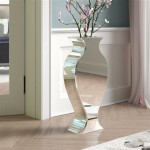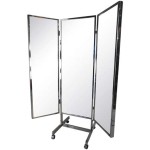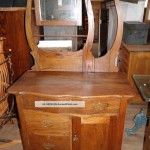Can You Get A TV That Looks Like A Mirror?
The intersection of technology and interior design has given rise to innovative products that seamlessly blend functionality with aesthetics. One such innovation is the mirror TV, a device that appears as a regular mirror when turned off but transforms into a functional television screen when powered on. This article explores the functionality, technology, applications, and considerations involved in acquiring a television that mimics the appearance of a mirror.
The concept of a mirror TV is relatively simple. The device uses a specialized two-way mirror that selectively reflects or transmits light depending on whether the TV is powered on or off. When the TV is off, the mirror reflects the ambient light, presenting a clear mirror image. When the TV is turned on, the light from the television screen overcomes the reflective properties of the mirror, allowing the image to be visible.
Several manufacturers offer mirror TVs with varying features, sizes, and price points. These TVs are designed to cater to individuals seeking a minimalist or high-end aesthetic in their living spaces. They are particularly popular in areas where a traditional television screen might appear obtrusive or undesirable.
The Technology Behind Mirror TVs
The core technology behind a mirror TV lies in the specialized two-way mirror. Unlike a standard mirror, which reflects nearly all light, a two-way mirror has a partially reflective coating. This coating allows a portion of the light to pass through while reflecting the rest. The specific ratio of reflection to transmission is carefully controlled to achieve the desired effect of a mirror when off and a clear television screen when on.
The quality of the mirror is crucial for both the reflective properties when the TV is off and the clarity of the image when the TV is on. High-quality mirrors are designed to minimize distortion and maintain color accuracy. The substrate material used in the mirror, such as glass or acrylic, also affects the overall performance and durability of the device.
Beneath the mirror lies the television screen itself. This screen employs standard LCD or LED technology, similar to that found in conventional televisions. The brightness and contrast ratio of the screen are important factors in overcoming the reflective properties of the mirror and delivering a clear, vibrant image. Manufacturers often use high-brightness panels to ensure optimal visibility, even in well-lit environments.
The integration of the mirror and the television screen requires careful engineering. The components must be precisely aligned to minimize parallax and ensure a seamless viewing experience. The design must also consider heat dissipation, as the enclosed space can lead to overheating, potentially affecting the longevity of the television components. Many manufacturers incorporate ventilation systems or heat sinks to mitigate this risk.
In many iterations, the standard TV components must be modified, accounting for the light loss of the two-way mirror by increasing the native brightness of the LED backlight. In some cases, this may reduce the lifespan of those components, and it is important to understand the warranty details before purchase. Regular televisions are not designed to emit light through a partially reflective surface.
Applications of Mirror TVs
Mirror TVs find applications in a variety of settings, from residential homes to commercial establishments. In residential spaces, they are often used in living rooms, bedrooms, and bathrooms to create a sleek and modern look. They can be particularly useful in smaller spaces where maximizing the sense of openness is desirable. By concealing the television screen when not in use, the mirror TV helps to declutter the visual environment and create a more harmonious aesthetic.
In bathrooms, mirror TVs offer the convenience of watching television while getting ready in the morning or relaxing in the bath. These TVs are typically designed to be water-resistant or waterproof to withstand the humid environment. They can be integrated into vanity mirrors or even directly into shower enclosures.
Commercial applications of mirror TVs include retail stores, hotels, and spas. In retail settings, they can be used to display advertisements or product information while simultaneously providing a mirror for customers to use. In hotels, they can be integrated into bathroom mirrors to provide entertainment and information to guests. In spas, they can create a relaxing and luxurious atmosphere, allowing clients to watch calming videos or listen to soothing music.
Beyond their aesthetic appeal and functional benefits, mirror TVs can also be used for practical purposes. For example, they can be integrated with smart home systems to display weather information, news headlines, or calendar appointments. They can also be used for video conferencing, allowing users to participate in meetings or video calls while maintaining a professional and polished appearance.
Considerations When Purchasing a Mirror TV
Before purchasing a mirror TV, several factors should be considered to ensure that the device meets the specific needs and requirements of the user. One of the most important considerations is the quality of the mirror itself. As mentioned earlier, a high-quality mirror is essential for both the reflective properties when the TV is off and the clarity of the image when the TV is on. It is important to look for mirrors that are made from high-quality materials and that have been treated to minimize distortion and maintain color accuracy.
Another important consideration is the brightness and contrast ratio of the television screen. The screen must be bright enough to overcome the reflective properties of the mirror and deliver a clear, vibrant image, even in well-lit environments. The contrast ratio should also be high enough to ensure that the image has good depth and detail.
The size and resolution of the television screen are also important considerations. The size of the screen should be appropriate for the viewing distance and the size of the room. The resolution of the screen should be high enough to provide a sharp and detailed image. For larger screens, a higher resolution is typically required to maintain image quality.
The connectivity options of the mirror TV are also important to consider. The TV should have sufficient HDMI ports to connect to external devices such as cable boxes, Blu-ray players, and gaming consoles. It should also have built-in Wi-Fi or Ethernet connectivity to access streaming services and other online content.
The design and aesthetics of the mirror TV are also important considerations, particularly if the device is intended to be a focal point in the room. Mirror TVs are available in a variety of styles, from minimalist and modern to ornate and traditional. It is important to choose a style that complements the overall décor of the room.
Finally, the price of the mirror TV is an important consideration. Mirror TVs are typically more expensive than conventional televisions due to the specialized components and manufacturing processes involved. It is important to shop around and compare prices from different manufacturers to find the best value for the money. Additionally, consider the associated installation costs, as professional installation is often recommended to ensure proper alignment and integration with the surrounding environment.
The installation process can be more complex than installing a standard television. The mirror TV needs to be securely mounted and properly aligned to ensure optimal viewing. It is important to follow the manufacturer's instructions carefully or to hire a professional installer to avoid damaging the device or the surrounding walls.
Maintenance of a mirror TV is relatively simple. The mirror surface can be cleaned with a soft cloth and a mild glass cleaner. It is important to avoid using abrasive cleaners or harsh chemicals, as these can damage the reflective coating. The television screen can be cleaned with a soft, dry cloth. It is important to avoid spraying liquids directly onto the screen, as this can cause damage.
The advent of smart mirrors offers another dimension to the mirror TV concept. Smart mirrors incorporate touch screen technology and embedded computing power, allowing users to interact with the mirror and access a variety of information and applications. These smart mirrors can display weather forecasts, news headlines, social media feeds, and other real-time data. They can also be used to control smart home devices, such as lights, thermostats, and security systems.
Some smart mirrors incorporate facial recognition technology, allowing them to personalize the user experience based on individual preferences. They can also be used for virtual makeup try-ons, providing users with a realistic preview of how different makeup products will look on their face. Smart mirrors represent a further evolution of the mirror TV concept, blurring the lines between mirrors, televisions, and computers.
Ultimately, acquiring a television that looks like a mirror is entirely feasible. The technology is readily available, and numerous manufacturers offer products catering to various needs and budgets. However, careful consideration of the factors outlined above is crucial to ensure that the chosen device meets the specific requirements of the intended application and provides a satisfying user experience.

75 Framed Samsung Led Mirror Tv Model Un75ju641

Disappearing Act Séura S Tv Mirrors Amaze Wolfers Lighting

Mirror Covered Tv They Should Make Tvs That Look Like Mirrors With Ornate Frames Until You Turn It On Cool Framed Over Fireplace Living Room Wall

Mirrors For Frames Larger Than Tv Screen Size

Samsung Mirror Tv Complete Guide For 2024 Models

Vanishing Tv Mirrors A That Looks Like Mirror Smart Home Automation Pro Commercial Company Hdh Tech

Japanese Architecture Featuring Mirror Television

Supply Custom Size Led Lighted Waterproof Bathroom Smart Magic Mirror Tv With Light Whole Factory Foshan Land Lighting Co Ltd

The Living Room Tv As We Know It Is Over Laurel Home

How To Hide The Tv With Style








